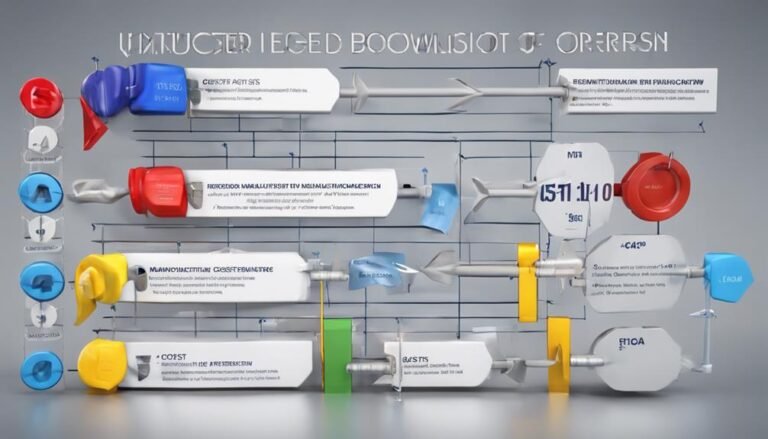What Is a Distribution Channel in Business and How Does It Work?
Distribution channels in business are essential pathways that involve a series of intermediaries to streamline product distribution. They contribute greatly to optimizing delivery processes, expanding market presence, and enhancing customer satisfaction. With components like producers, agents, and retailers, these channels can be direct, indirect, or hybrid to suit different strategies. Efficient management guarantees smooth flow of goods, inventory control, and meeting consumer demands effectively. Intermediaries act as important links between manufacturers and end consumers, managing inventory challenges and forming strategic alliances for market penetration. Understanding the dynamics and intricacies of distribution channels is key to business success and growth.
Key Takeaways
- Distribution channels are strategic pathways connecting producers to end consumers via intermediaries.
- They optimize product movement, expand market reach, and enhance customer satisfaction.
- Channels can be direct, indirect, or hybrid, crucial for efficient distribution strategies.
- Distribution management ensures seamless flow, inventory optimization, and meeting consumer demand effectively.
- Intermediaries act as bridges, manage inventory challenges, and form strategic partnerships for market reach.
Definition of Distribution Channels
Distribution channels in business serve as the strategic pathways through which goods and services navigate from producers to end consumers. This encompasses a network of intermediaries facilitating the flow of products in the marketplace.
The role of distribution channels in marketing is vital, as they directly impact a company’s channel strategy. This influence extends to how products are delivered and reach customers efficiently.
Channel strategy involves decisions on the most effective routes to market, considering factors such as product type, target market, and competition.
By optimizing distribution channels, businesses can enhance their market reach, guarantee timely product delivery, and ultimately improve customer satisfaction.
A well-thought-out channel strategy plays a significant role in driving sales, building brand reputation, and supporting overall business success.
Components and Types of Channels
One of the critical aspects to explore when delving into the network of businesses facilitating the flow of goods and services to end consumers is understanding the components and various types of channels available in the distribution process. Channel selection and strategy play a pivotal role in determining how products move from producers to consumers efficiently.
Components of distribution channels typically include the producer, agent, wholesaler, retailer, and end consumer. The types of channels range from direct channels, where consumers purchase directly from the manufacturer, to indirect channels involving wholesalers and retailers, and hybrid channels that combine both direct and indirect methods.
Understanding these components and types is essential for businesses to design effective distribution strategies that optimize product reach and customer satisfaction while achieving business objectives.
Wholesalers play a pivotal role in indirect distribution channels by bridging the gap between manufacturers and retailers. For businesses exploring opportunities with some of the biggest wholesalers in USA, this resource offers a comprehensive directory to streamline their supply chain operations.
Importance in Business Operations
In examining the network of businesses involved in facilitating the movement of goods and services to end consumers, it becomes evident that the efficiency and strategic management of distribution channels play a fundamental role in the operational success of businesses.
- Efficiency Optimization: Streamlining distribution processes enhances overall operational efficiency.
- Market Expansion Opportunities: Well-managed channels open avenues to tap into new markets and increase consumer reach.
- Cost-Effective Delivery: Efficient channels lead to cost savings in delivery operations.
- Enhanced Customer Satisfaction: Smooth distribution channels contribute to improved customer experiences and loyalty.
Strategically optimizing distribution channels not only guarantees the timely delivery of products but also provides avenues for market growth and enhanced customer relationships, ultimately contributing to the overall success of the business.
Functions of Distribution Management
Efficient management of distribution functions is an essential component in ensuring the seamless flow of goods from suppliers to end customers, optimizing inventory levels, and meeting consumer demand effectively.
Inventory optimization is a key aspect of distribution management, ensuring that the right amount of stock is available at the right place and time to prevent stockouts or excess inventory costs.
Additionally, supply chain coordination plays a vital role in streamlining the movement of goods through various channels, aligning activities among suppliers, manufacturers, wholesalers, and retailers to enhance overall efficiency.
Role of Intermediaries
Optimizing the role of intermediaries in distribution channels is imperative for enhancing the efficiency and effectiveness of product movement from producers to end consumers.
- Intermediaries’ Impact: They bridge the gap between manufacturers and consumers, facilitating the smooth flow of goods.
- Intermediaries’ Challenges: Dealing with inventory management, ensuring timely deliveries, and adapting to changing market demands.
- Strategic Partnerships: Collaborating with intermediaries can lead to improved market reach and customer satisfaction.
- Technological Integration: Leveraging digital platforms can streamline processes and enhance communication within the distribution channel.
Balancing the impact and challenges faced by intermediaries is essential for a successful distribution strategy that meets both business and consumer needs effectively.
Conclusion
To sum up, the intricate web of distribution channels in business functions as the lifeline for product movement and market accessibility. With diverse components and types, efficient distribution management and intermediary involvement are essential for optimizing supply chain performance.
As businesses navigate the complex landscape of distribution channels, one must ponder: How can strategic channel selection drive competitive advantage and enhance customer satisfaction in today’s dynamic marketplace?







